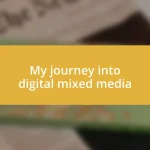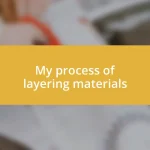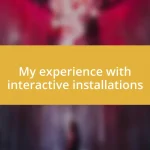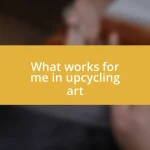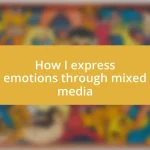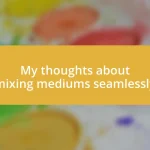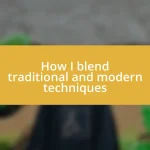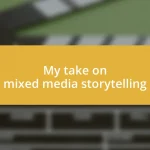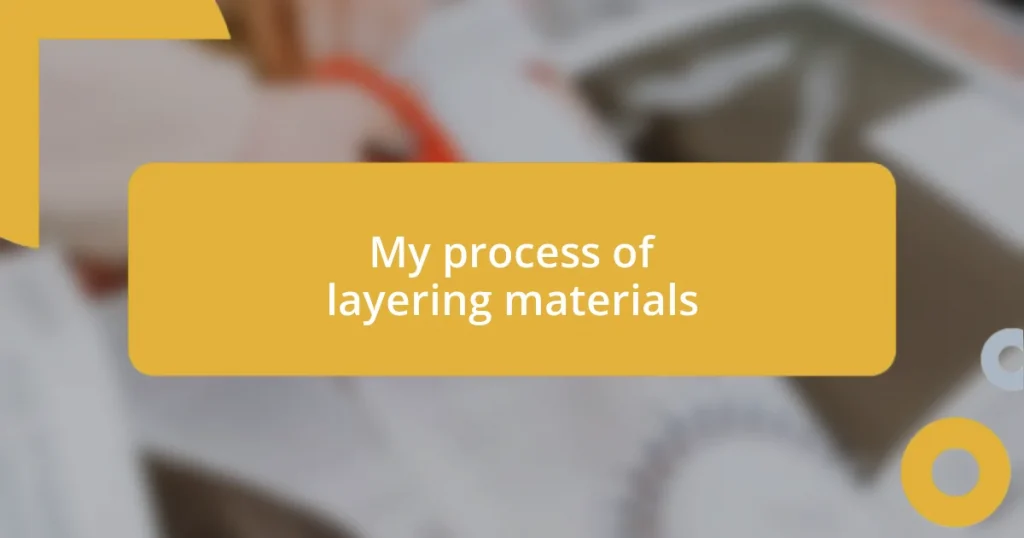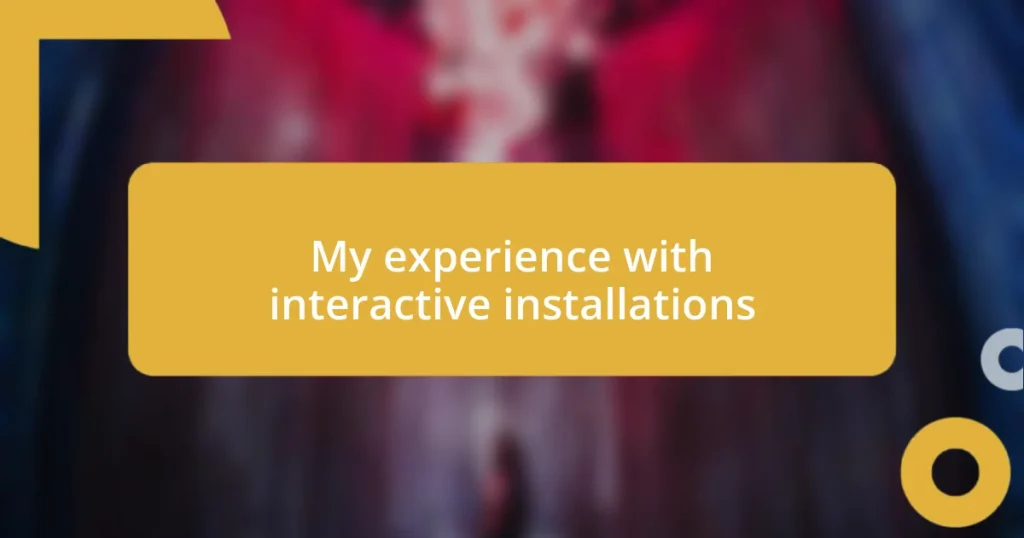Key takeaways:
- Discovering digital mixed media ignited a personal journey of creativity, emphasizing the blend of traditional and digital techniques.
- Setting up an inspiring workspace enhances productivity, highlighting the importance of proper lighting, ergonomics, and organization.
- Sharing art on social media and participating in exhibitions fosters community engagement and validates the creative process.

Discovering digital mixed media
The moment I first stumbled upon digital mixed media was almost serendipitous. One evening, while scrolling through social media, I encountered an artist blending traditional painting with digital elements. I couldn’t help but wonder how this seamless fusion could unlock new realms of creativity. It sparked a curiosity within me, igniting the desire to explore this technique for myself.
I recall my initial attempts to grasp the tools of digital creation. I felt overwhelmed by the myriad of software options available; each seemed to hold endless possibilities yet posed a significant learning curve. Have you ever felt that rush of excitement and frustration simultaneously? It was a rollercoaster of emotions as I navigated through my first digital canvas, unsure of where to start but eager to experiment.
As I dived deeper into the world of digital mixed media, I began to appreciate the freedom it offered. I found myself layering textures, images, and colors in ways I never thought possible. The magic of blending real-world elements with digital techniques created a sense of liberation. Have you experienced that feeling where inspiration flows so freely it feels almost tangible? For me, each project became not just an artwork, but a journey of self-discovery and expression.

Setting up your workspace
Creating a workspace that inspires creativity can significantly impact your digital mixed media journey. When I set up my own space, I ensured it reflected my artistic spirit. I arranged my desk with my tablet, stylus, and a cozy spot for sketchbooks and reference materials. The environment should stimulate your imagination while keeping you comfortable.
Here’s what I recommend for setting up an effective workspace:
- Lighting: Natural light can boost your mood; a good desk lamp is essential for late-night inspiration.
- Ergonomics: Invest in a comfortable chair and adjustable desk to avoid strain during long sessions.
- Organization: Use storage solutions for your tools and materials to keep things clutter-free and accessible.
- Inspiration Board: Create a board with images, colors, and quotes that motivate you.
- Sound: Whether it’s music, podcasts, or silence, find what helps you focus and enjoy the process.
I remember how important it was for me to find that balance. I once shifted my workspace to a room with a larger window, and the change sparked more creativity in my projects. It’s amazing how the right setup can ignite fresh ideas within you!

Exploring essential tools
Exploring essential tools in digital mixed media can transform your creative journey. I vividly remember how choosing the right software felt like finding a hidden treasure. Initially, I experimented with a few popular programs, and each had its own charm and unique features. For instance, while some focused on image manipulation, others excelled in painting and illustration. It was exhilarating to discover how different tools could lead to distinct creative outcomes.
I found that my go-to tools often aligned with my artistic sensibility. For example, applications like Procreate didn’t just allow me to draw, but provided an intuitive interface that felt like I was using traditional media. Conversely, Adobe Photoshop opened a universe where I could edit photos and blend layers with unmatched versatility. The key is to explore these tools and identify which resonates with your style.
Here’s a quick comparison of essential tools I’ve encountered:
| Tool | Purpose |
|---|---|
| Procreate | Digital painting and illustration |
| Adobe Photoshop | Photo editing and manipulation |
| Corel Painter | Traditional painting simulation |
| Affinity Designer | Vector and graphic design |
| Krita | Open-source painting and illustration |
Reflecting on my journey, I realize that experimenting with these tools not only honed my skills but opened avenues for limitless expression. Have you found a tool or software that truly speaks to you? For me, grasping their capabilities was like gaining a new language in which to express my artistic voice.

Techniques for creating mixed media
When it comes to techniques for creating digital mixed media, layering is one of my favorites. I often start by creating a base layer that sets the mood—this could be a textured background or a color gradient. This initial choice guides the rest of the piece, and I’ve found that it influences how each subsequent layer interacts with it. Have you ever noticed how a simple texture can add depth and character to a piece? It’s one of those elements that truly transforms an artwork from something flat to a vibrant expression.
Another technique I enjoy is experimenting with blending modes. These have been game-changers in my creative process. By adjusting how layers interact with one another, I can create effects that surprise even me. For instance, when I blended a watercolor effect with a photographic layer, the result was a dreamy quality that took my piece to another level. Have you tried this in your work? Mixing styles has brought so much excitement and variety to my projects, opening doors I never thought possible.
Finally, don’t underestimate the power of digital collage. Combining various digital assets—like photographs, textures, and hand-drawn elements—has allowed me to create complex narratives within my art. I remember stitching together images of nature with urban landscapes, resulting in pieces that reflect my inner struggle between the two worlds. It almost speaks to the contrasts we experience in life, wouldn’t you agree? This technique not only feeds my creativity but also invites viewers into a conversation about their interpretations of blended realities.

Combining traditional and digital methods
Combining traditional and digital methods has been a game changer in my artistic journey. I vividly recall the first time I scanned a hand-painted piece and layered it with digital effects; it felt like bridging two worlds, where the warmth of my brushstrokes met the precision of pixel manipulation. Have you ever experienced that moment when you realize the potential for synergy between these mediums? It’s an exhilarating feeling to watch your work evolve in unexpected directions.
There’s something uniquely satisfying about using traditional tools, like watercolors or charcoal, to create textures that I then manipulate digitally. This approach allows me to infuse my work with tangible authenticity. I recently experimented by blending a textured watercolor background with sharp digital lines, which created a striking contrast that I couldn’t have achieved with either method alone. How do you think the interplay of textures can enhance a piece? In my experience, it’s the imperfections of traditional mediums that shine through, adding depth and a personal touch to the final artwork.
Additionally, I’ve found that digitally manipulating my sketches can breathe new life into them. I sometimes start with pencil and paper, and the spontaneity of traditional sketching captures my initial thoughts. Then, once I digitize those sketches, the editing possibilities are endless. When I first added digital colors and layers to a simple pencil drawing, it felt like unlocking a hidden dimension of my creativity. It sparks a playful dialogue between the rawness of my original work and the sleekness of the digital realm. Have you explored using both mediums in your projects? I genuinely believe that this fusion can elevate your artistic expression to new heights.

Showcasing and sharing your art
Showcasing your art is as vital as creating it. I remember my first time sharing a piece online; the butterflies in my stomach were intense. Introducing your work to the world takes courage and vulnerability. Have you ever shared something so personal and felt a sense of relief afterward? That mix of fear and excitement can transform your relationship with your art.
Social media platforms have become a powerful avenue for showcasing digital mixed media. I’ve found that platforms like Instagram and Pinterest allow for effortless sharing of visual stories. Engaging with comments and reactions from viewers can be exhilarating—it’s a validation of your creative voice. What’s fascinating is how a simple post can connect you with artists and admirers around the globe, turning solitary work into a vibrant community experience.
Participating in online exhibitions or local art fairs adds another layer of visibility to your craft. My first booth at a local art fair was daunting yet rewarding. Seeing people stop, engage, and even purchase my pieces was a validation of my journey. It’s incredibly fulfilling to witness how your work resonates with others. Have you ever felt the energy in a space filled with art? There’s something magical about the shared enthusiasm that can inspire you to push your creative boundaries even further.

Continuing your creative journey
As I look back on my artistic evolution, I realize that nurturing creativity is an ongoing journey, not a destination. I often ask myself, “What new techniques can I explore today?” Recently, I decided to attend a workshop on digital illustration, and it opened up a whole new realm of possibilities for my mixed media projects. It was here that I discovered the magic of layering digital textures—a simple technique that transformed my approach to composition.
I’ve learned that connecting with fellow artists can significantly enhance your creative journey. During a recent art retreat, I found myself sharing ideas with others while working side by side. It made me recognize how collaborative environments can spark inspiration. Has there been a moment when sharing your thoughts led to an unexpected breakthrough? I believe those exchanges can cultivate a sense of community and propel our work in exciting new directions.
Embracing failure as a stepping stone is another essential part of continuing my creative journey. I remember a project that went horribly wrong, where I overlaid too many effects and lost sight of my original vision. At first, I was crushed, but then I realized that it was a learning opportunity. I could take those mistakes and turn them into teaching moments for myself. So, I challenge you: what would happen if you turned your creative missteps into unexpected inspirations? Sometimes, it’s the rough paths that lead us to the most beautiful destinations in our art.
